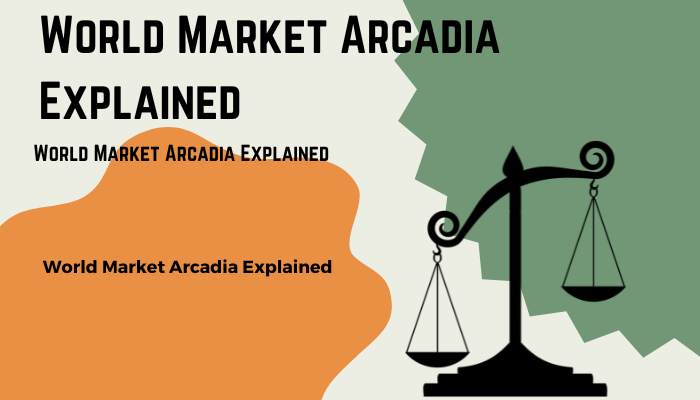Introduction
The concept of a “World Market” in Arcadia represents a dynamic and interconnected global marketplace, blending diverse cultures, economies, and industries. This vibrant ecosystem not only facilitates international trade and investment but also fosters cultural exchange and innovation, making it a cornerstone of the modern global economy.
The Genesis of World Market Arcadia
Historical Context
The inception of World Market Arcadia is rooted in the ancient Silk Road, embodying the spirit of trade and cultural exchange. This section delves into the historical evolution from traditional bazaars to the sophisticated global networks we see today.
Economic Evolution
Tracing the economic transformations that led to the emergence of Arcadia as a hub in the world market, this part explores the shift from agrarian economies to industrial and eventually to the predominance of the service and digital economy.
Structure and Operations
The Digital Marketplace
In the digital age, World Market Arcadia extends beyond physical boundaries, existing in the virtual realm where transactions are instantaneous. This section examines the platforms and technologies that enable this seamless global interaction.
Supply Chain Dynamics
The intricate logistics and supply chains that underpin the World Market Arcadia are crucial for its operation. Here, we dissect the global supply chain, highlighting the role of logistics, transportation, and warehousing in maintaining the flow of goods and services.
Economic Impact
Global Trade Networks
Understanding the global trade networks that facilitate the exchange of goods and services in Arcadia is essential. This includes analyzing trade agreements, tariffs, and the role of international organizations in regulating and promoting global trade.
Investment and Growth Opportunities
The World Market Arcadia is not just a trade hub; it’s a beacon for investment. This section explores the investment opportunities it presents, from emerging markets to technology startups, and how these contribute to global economic growth.
Cultural Exchange
The Melting Pot of Cultures
At its heart, World Market Arcadia is a melting pot of cultures, bringing together diverse traditions, cuisines, and artistic expressions. This cultural exchange fosters global understanding and unity.
Innovation and Trends
The convergence of different cultures and ideas in Arcadia often leads to innovation. Here, we’ll explore how these interactions spark new trends in technology, fashion, food, and more, shaping global consumer behavior.
Challenges and Controversies
Environmental Concerns
The environmental impact of global trade cannot be overlooked. This section addresses the sustainability challenges faced by World Market Arcadia, from carbon emissions to waste management, and the initiatives being undertaken to mitigate these effects.
Ethical and Labor Issues
The ethical considerations, including labor rights and fair trade practices, are critical in the operation of the World Market Arcadia. We’ll examine the controversies and the steps being taken to ensure ethical compliance in global trade practices.
The Future of World Market Arcadia
Technological Advancements
Emerging technologies like AI, blockchain, and IoT hold the potential to transform the World Market Arcadia. This part forecasts how these technologies might redefine global commerce and cultural exchange.
Globalization vs. Localization
The tension between globalization and the desire for local identity and autonomy presents a complex challenge for World Market Arcadia. This section explores the balancing act between global integration and respecting local cultures and economies.
The History of the World Market Arcadia
Introduction
The concept of the World Market Arcadia captures the essence of global trade and cultural exchange throughout history. Its origins and evolution mirror the advancements in transportation, communication, and economic policies that have progressively knitted the world’s markets closer together.
Prehistoric Trade Networks
The Dawn of Trade (Up to 3000 BCE)
- Beginnings of Exchange: Early human societies engaged in barter systems, exchanging goods like flint tools, pottery, and foodstuffs.
- Early Trade Routes: Nomadic tribes initiated the first trade routes, which were limited but laid the groundwork for future trade expansions.
Ancient World Markets
Mesopotamia and the Fertile Crescent (3000 BCE – 500 BCE)
- Trade Hubs Emerge: Mesopotamia, often cited as the cradle of civilization, became a bustling center for trade, connecting the East and West.
- Goods and Currency: Introduction of the shekel, one of the first forms of currency, facilitating easier trade of goods like textiles, grains, and metals.
The Silk Road and Beyond (200 BCE – 1450 CE)
- Silk Road Establishment: A network of trade routes connecting China to the Mediterranean, facilitating the exchange of silk, spices, tea, and ideas.
- Cultural Exchange: The Silk Road also became a conduit for cultural, religious, and technological exchanges between the East and West.
Medieval to Early Modern Trade
The Age of Discovery (15th – 17th Century)
- European Exploration: European powers embarked on expeditions, discovering new lands and establishing trade routes to Asia, Africa, and the Americas.
- Colonialism and Trade: The era saw the rise of colonial empires, which had a profound impact on global trade patterns, often at great human cost.
The Atlantic Slave Trade (16th – 19th Century)
- A Dark Chapter: An integral part of the triangular trade, involving the forced migration of Africans to work in New World colonies.
- Economic Impact: The slave trade contributed to the economic development of the colonies but left a lasting legacy of trauma and inequality.
Industrial Revolution and Global Markets
The Birth of the Modern Economy (18th – 19th Century)
- Industrialization: The advent of mechanized production transformed economies, leading to increased production and the growth of a global market.
- Transportation Revolution: Innovations in transportation, such as the steam engine and railways, drastically reduced trade times and costs.
20th Century: Wars, Depression, and Recovery
World Wars and Economic Turmoil (1900-1945)
- Global Conflicts: The world wars disrupted global trade networks, leading to economic instability and the Great Depression.
- Post-War Recovery: The establishment of the Bretton Woods system and the creation of institutions like the IMF and World Bank aimed at stabilizing global economies.
The Late 20th Century: Globalization Intensifies (1945-2000)
- Technological Advances: Innovations in communication and logistics, such as container shipping and the internet, further globalized trade.
- Economic Policies: The reduction of trade barriers and the establishment of trade agreements promoted an era of unprecedented economic integration.
21st Century: Digital Age and Beyond
The Rise of E-Commerce (2000-Present)
- Digital Revolution: The internet transformed the retail landscape, enabling the rise of e-commerce and opening global markets to small-scale producers and retailers.
- Global Challenges: Issues such as climate change, ethical trade practices, and economic inequality pose challenges to the global market system.
The Different Types of World Market Arcadia
21st Century: Digital Age and Beyond
The dawn of the 21st century has been marked by unprecedented technological advancements, significantly altering the landscape of the World Market Arcadia. The digital age has democratized access to global markets, revolutionized how we conduct business, and presented new challenges and opportunities.
The Rise of E-Commerce (2000-Present)
Transformation of Retail
The internet era ushered in a new paradigm for retailers and consumers alike. E-commerce platforms like Amazon and Alibaba have become household names, enabling consumers to shop from anywhere in the world. This digital revolution has led to the decline of traditional brick-and-mortar stores and the rise of online marketplaces.
Democratization of the Marketplace
Small and medium-sized enterprises (SMEs) now have the opportunity to reach a global audience with minimal upfront investment, leveling the playing field and fostering a more inclusive global economy. Platforms such as Etsy and Shopify empower artisans and small business owners by providing them with the tools to sell globally.
Advancements in Logistics and Payment Systems
The growth of e-commerce has been supported by significant advancements in logistics and payment systems. Drone deliveries, same-day shipping, and digital wallets are just a few examples of the innovations that have made online shopping more convenient and accessible.
Blockchain Technology
Blockchain is poised to revolutionize global trade by enhancing transparency, security, and efficiency in transactions. Smart contracts and cryptocurrencies facilitate faster and more secure international payments, reducing the need for intermediaries and lowering transaction costs.
Global Challenges
Digital Divide
While the digital age has brought about numerous opportunities, it has also highlighted the digital divide between and within countries. Access to the internet and digital literacy remains a barrier for many, limiting their ability to participate in the global digital economy.
Cybersecurity Concerns
The increase in online transactions has led to a rise in cybercrime. Ensuring the security of personal and financial information remains a significant challenge for online retailers and consumers.
Environmental Impact
The convenience of online shopping has led to increased packaging waste and carbon emissions from delivery vehicles. Sustainable practices and eco-friendly innovations are needed to mitigate the environmental impact of e-commerce.
Looking Forward
The future of the World Market Arcadia in the digital age is both promising and challenging. Innovations in AI, machine learning, and IoT are expected to further transform global commerce, making it more personalized, efficient, and sustainable. However, addressing the digital divide and cybersecurity threats will be crucial in ensuring that the benefits of the digital marketplace are accessible to all.
By focusing on these aspects, we can begin to jobs understand the complex tapestry of the World Market Arcadia’s history and its evolution into the digital age. The transformation of global commerce through technology presents a unique set of opportunities and challenges that will shape the future of trade and economic interaction worldwide. As this market continues to evolve, it will undoubtedly continue to influence global culture, economics, and societal structures in profound ways.




